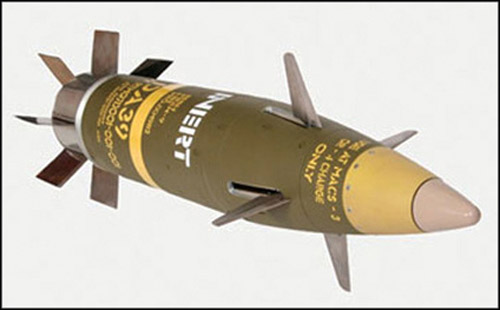The advantage of this is that, even if the shell is shot off-target, it automatically glides toward the target. When fired in MRSI mode, these shells can raze a single building to the ground without any damage to neighbouring buildings. The American ‘Excalibur (M982),’ a product of Raytheon Missile Systems, and ‘Bofors’ of BAE Systems, are the only known examples. Typically, the estimated cost of a single shell is around US$ 50,000!
Sensor-fused tank killer shells
Meant to take out enemy tanks, these shells act as carriers and deploy smaller, standalone, smart anti-tank munitions that take out tanks. Each smart submunition contains a flight computer, radar and an explosive detonating mechanism. When the shell reaches the target area, submunition are ejected out and slowly descend through a parachute and spin. While spinning, the submunition’s radar is activated. The radar maintains a spiral-scanning pattern during descent. When the flight computer recognises the radar echoes of a tank, the computer simply jettisons the parachute. This allows the submunition to fall over the target. An explosive detonating mechanism detonates the explosive. The result is an explosively-formed penetrator (EFP), a molten-copper jet travelling at hypersonic speeds. This jet penetrates the tank’s weakest place—its top. In case the submunition is not able to find any tank, it automatically explodes and destructs itself. The American ‘SADARM M898,’ German ‘Suchzünder Munition für die Artillerie 155’ (meaning ‘sensor-fused munition for 155mm artillery’) and ‘BONUS’ of BAE systems are the presently operational shells.

An entire armoured offensive of the enemy could be blunted by batteries of howitzers firing such sensor-fused shells.
Jammer shells
These shells are of a different genre. They consist of a high-powered radio frequency (RF) jammer that jettisons through a parachute and lands in the target area. After impacting the ground, it starts emitting high-power noise in a particular RF band. This turns all communication systems that use that particular band in the target area ‘deaf and dumb.’ Less than a dozen of these rounds, jamming various bands, can completely choke all communication systems for a definite period. The military application of this system is vast and spreads over various doctrines. So far, such shells are said to be available with the Russian forces in limited scale.
Command and control systems
Each combat leader in the echelon gets his orders from his superior based on ground situation, delegates a task to his subordinate units and reports back the result to his superior. This process is called command and control (C2) and is based on robust communication systems. The C2 is to be maintained from the top to the bottom level forces—be it a 4-6 member team or 40,000-50,000 strong strike corps. The performance of a fighting force is directly influenced by the efficacy of C2. Tanks and SPGs, crucial to a battle, are highly communication-intensive systems.
Communication systems for tanks
With improvements in communication technology, a better C2 has become possible, from intra-tank communication to inter-tank communication. Due to the immense noise associated with the tanks, direct voice communication is not even possible between the tank crew seated next to each other. Helmet-mounted headphone intercoms are used for intra-tank voice communication. These are plugged into a wired two-way communication system. With the inter-tank communication mode selected, the tank commander can communicate with other tank commanders in the formation or his superiors using a wireless radio transceiver. The warning from the active protection system (APS) is coupled with the intercom system. The commander hears a warning tone if his tank is targeted—an eventual sign of an impending missile attack. A specially-designated tank with a better communication facility, called command tank, is also used. This tank hosts the formation commander, who commands the tank commanders of the formation. He or she also communicates with the higher echelons.
Due to the changing geopolitics, combined infantry-armour operations are required inside the cities. This requires the infantry to move in close proximity with the tanks. To facilitate better infantry vs tank communication, telephones are being progressively installed in the rear of the tanks. The associated commander can directly communicate with the tank’s commander through these phones.
With the development of communication technology, tanks are better able to share information. In modern tanks, the commander has a touch-screen interactive display that shows the map of the terrain he is operating in. This is frequently updated by satellites, which helps the tank commander to view the graphical disposition of his own and known enemy troops in the battlefield. He also gets on-field intelligence through unmanned aerial vehicles that transmit live video or image feeds to the tanks. The tank forces—the main strike forces—are slowly switching towards network-enabled capabilities. Through this they share information, designate targets and neutralise them very effectively in close cohesion.






